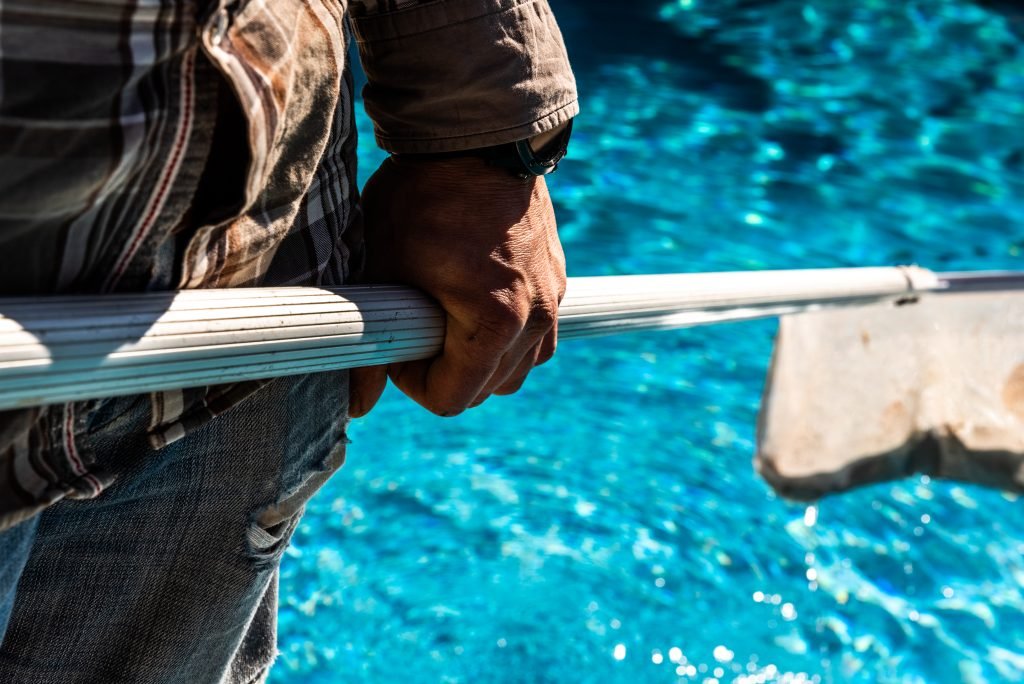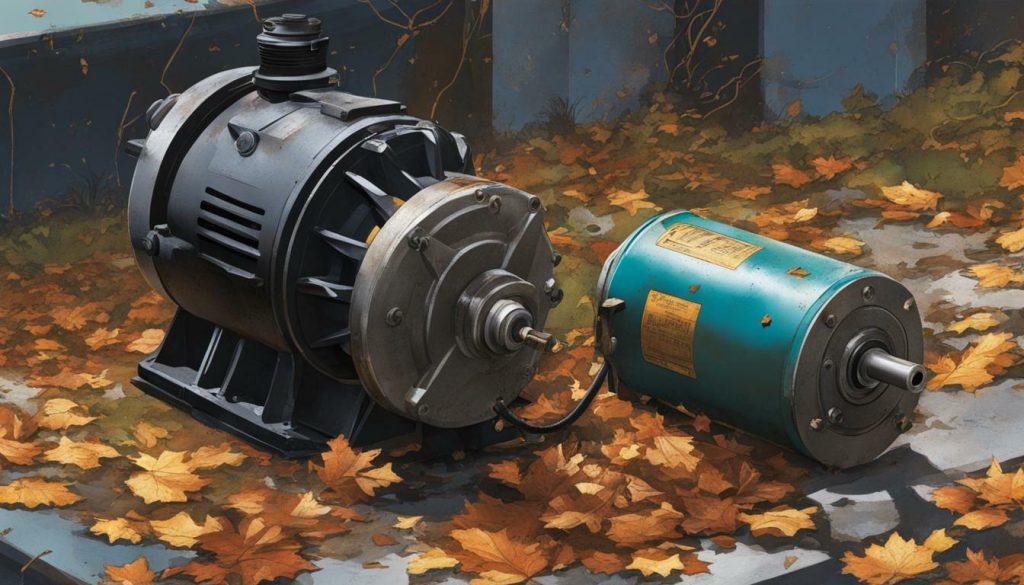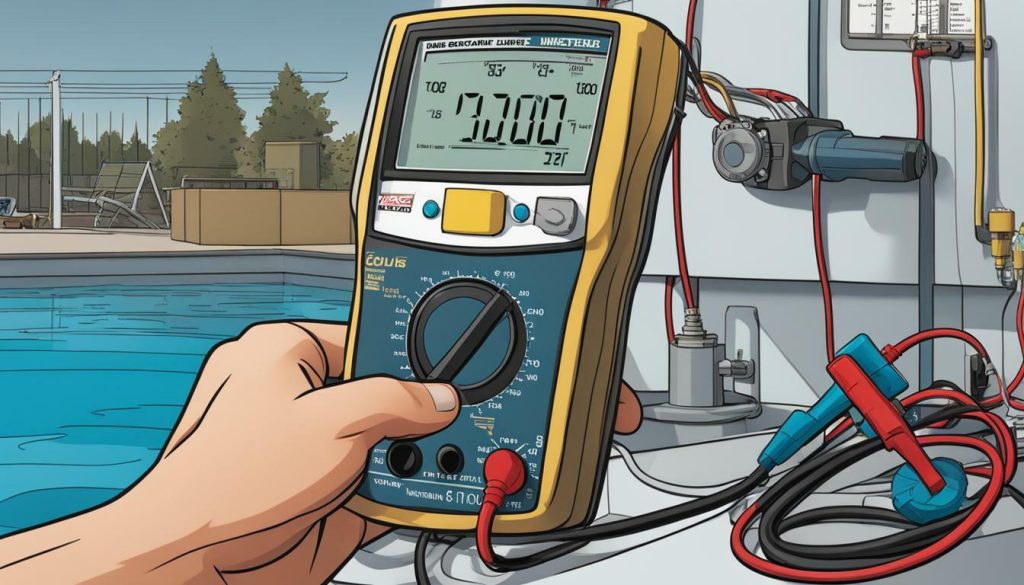Maintaining your pool pump is essential for its optimal performance and longevity. By following these tips, you can ensure that your pool pump remains in good working order.
Regular maintenance and proper care are crucial for keeping your pool pump in optimal condition. Neglecting maintenance can lead to various issues such as power problems, strange sounds, flow problems, pump problems, and leaks. To avoid these problems and extend the life of your pool pump, here are some key maintenance tips to follow:
Key Takeaways:
- Regularly check and clean the impellers to prevent clogs and ensure efficient water flow.
- Inspect and replace capacitors or shaft seals if necessary to prevent electrical issues and leaks.
- Maintain proper water levels in your pool to avoid flow problems and protect the pump.
- Check electrical connections and wiring to troubleshoot power problems and ensure safe operation.
- Address any strange sounds immediately, as they may indicate underlying issues that require attention.
By following these pool pump maintenance tips, you can enjoy a well-functioning and efficient pool pump for years to come.
Cleaning Your Pool Pump
Regular cleaning of your pool pump is necessary to remove debris and prevent clogs that can hinder its functionality. Additionally, it is essential to maintain other pool equipment to ensure a healthy and clean swimming environment. By following these pool maintenance guidelines, you can keep your pool pump running smoothly and extend its lifespan.
1. Remove Debris: Start by turning off the pump and removing the strainer basket lid. Empty the basket of any leaves, twigs, or other debris that may have accumulated. Use a hose or a brush to clean the basket and remove any stubborn dirt.
2. Clean the Impeller: The impeller is responsible for circulating water through the pump. Over time, it can become clogged with debris, affecting the pump’s efficiency. To clean the impeller, remove the bolts holding the pump housing together and access the impeller. Remove any debris or buildup carefully, making sure not to damage the impeller or its blades.
3. Inspect and Replace Seals: The shaft seal and gaskets play a crucial role in preventing leaks. Inspect them regularly for signs of wear and tear, such as cracks or leaks. If necessary, replace the seals to maintain the pump’s integrity.
4. Check and Clean Filters: Dirty or clogged filters can restrict water flow and strain the pump. Clean or replace the filters as needed to ensure proper filtration and prevent debris from reaching the pump.
5. Maintain Water Chemistry: Properly balanced water chemistry is essential for maintaining a clean and healthy swimming environment. Regularly test the water and adjust the chemical levels as recommended to prevent corrosion or buildup that could damage the pump.
Remember to consult your pool pump’s manufacturer’s guidelines for specific cleaning and maintenance instructions. By following these pool equipment maintenance tips, you can keep your pool pump in optimal condition and enjoy crystal clear water all season long.
Recommended Equipment for Pool Pump Maintenance
To effectively clean and maintain your pool pump, you may need the following equipment:
- Pool brush
- Hose
- Filter cleaner
- Screwdriver or wrench
- Replacement seals
- Water testing kit
Having these tools readily available will make it easier to perform regular maintenance tasks and keep your pool in top shape.
| Pool Maintenance Checklist | Frequency |
|---|---|
| Clean strainer basket | Weekly |
| Inspect and clean filters | Monthly |
| Check and replace seals | Every 6 months |
| Test water chemistry | Weekly |
Following this maintenance checklist will help you stay on top of your pool pump’s upkeep and ensure its optimal performance throughout the year.

Troubleshooting Common Pool Pump Issues
Despite regular maintenance, pool pump issues can still occur. This section offers troubleshooting techniques to address common problems and a helpful maintenance checklist to keep your pump running smoothly. By following these steps, you can ensure that your pool pump operates efficiently, extends its lifespan, and keeps your pool clean and inviting.
Electrical Issues:
If your pool pump won’t power up, check the breakers, timers, and wiring. It’s essential to ensure all connections are secure and that there is no damage to the electrical components. If the pump shuts off immediately after turning on, it may be due to an electrical problem or a failing capacitor. Random shutdowns may occur due to motor overheating or using a circuit breaker as an on-off switch.
Strange Sounds:
Strange noises such as humming or screeching can indicate problems with your pool pump. Clogged impellers, faulty capacitors, worn bearings, or damaged shaft seals can all cause these sounds. Vibrating noises could be a result of an uneven base, worn bearings, or cavitation. If you notice any unusual sounds, it’s important to investigate and address the issue promptly to prevent further damage.
Flow Problems and Leaks:
Flow problems can be caused by low water levels, clogged baskets, or air in the system. It’s vital to check for any blockages, clean or replace clogged baskets, and ensure proper water levels to maintain a consistent flow rate. Leaks may be due to faulty pump lids or shaft seals. If you suspect a leak, inspect all seals and connections, and replace any damaged or worn-out parts.
To troubleshoot these issues effectively, refer to the maintenance checklist provided below:
| Issue | Troubleshooting Steps |
|---|---|
| Electrical Problems | – Check breakers, timers, and wiring connections – Inspect capacitors for signs of damage or failure – Ensure proper ventilation and cooling for the motor |
| Strange Sounds | – Clean or replace clogged impellers – Inspect bearings, capacitors, and shaft seals for damage – Address any vibrations or cavitation issues |
| Flow Problems | – Maintain proper water levels in the pool – Clean or replace clogged baskets – Bleed air from the system |
| Leaks | – Inspect pump lids and shaft seals for damage – Replace any faulty or worn-out parts – Ensure proper sealing and connections |
Regular maintenance that includes periodic checks and prompt repairs can help extend the life of your pool pump and avoid costly replacements. By staying proactive and addressing issues as they arise, you can enjoy a well-functioning pool and a worry-free swimming experience.

Power Problems and Electrical Checks
When your pool pump fails to power up, it’s crucial to check the breakers, timers, and wiring to determine the source of the problem. Power problems can prevent your pump from running efficiently or at all, affecting the cleanliness and circulation of your pool water. Here are some steps to take in troubleshooting power issues:
- Start by inspecting the circuit breakers. Sometimes, a simple reset of the breaker can solve the problem. Ensure that the breaker is in the “On” position and not tripped.
- Check the timer settings. If the timer is not properly programmed, the pump may not receive power during the designated operating hours. Adjust the timer settings as needed.
- Examine the wiring connections. Loose or damaged wires can disrupt the flow of electricity to the pump. Carefully inspect the wiring, ensuring all connections are secure and intact. If any wires are frayed or damaged, they should be replaced.
- Test the voltage at the pump using a multimeter. This will help determine if the pump is receiving the correct voltage. If the voltage is lower than what’s required, it may indicate an issue with the electrical supply or the wiring.
To perform these electrical checks safely and accurately, it is recommended to consult a professional electrician or pool technician. They have the expertise and tools necessary to diagnose and resolve electrical problems effectively.
Remember, power problems can be complex, and it’s essential to address them promptly to avoid further damage and ensure the optimal performance of your pool pump. Regular maintenance, including electrical checks, can help identify and prevent power-related issues, extending the life of your pool pump.

| Common Power Problems | Possible Causes | Solution |
|---|---|---|
| Pump won’t power up | Tripped breakers, faulty timers, loose or damaged wiring | Reset breaker, adjust timer settings, inspect and repair wiring |
| Pump shuts off immediately after turning on | Electrical problem, failing capacitor | Consult a professional electrician or pool technician to diagnose and repair |
| Random shutdowns | Motor overheating, using a circuit breaker as an on-off switch | Inspect motor for overheating issues and avoid using circuit breaker as a switch |
Common Pump Issues and Strange Sounds
Strange sounds emanating from your pool pump can indicate underlying issues such as clogged impellers, problems with capacitors, bearings, or shaft seals. This section will guide you on troubleshooting and resolving these problems.
When you hear a humming sound coming from the pump, it may be due to clogged impellers. This can restrict water flow and put additional strain on the motor. To resolve this, turn off the pump and disconnect the power. Remove the pump’s housing and inspect the impellers for any debris or blockages. Clean them thoroughly and ensure they move freely.
If you notice screeching or grinding noises, it could be a sign of worn bearings or problems with the shaft seals. Over time, bearings can wear out, causing friction and noise. Similarly, worn or faulty shaft seals can lead to leaks and unusual sounds. In such cases, it is advisable to replace the bearings or seals to restore smooth operation.
In some instances, vibrating noises may be heard when the pump is running. This can be a result of an uneven base, worn bearings, or cavitation. Cavitation occurs when air bubbles form and collapse within the pump, causing vibration and noise. Check the pump’s base for stability and adjust if necessary. If the issue persists, inspect the bearings for signs of wear and replace if needed. Additionally, ensure there are no clogs or blockages in the system that may lead to cavitation.
Pool Pump Maintenance Checklist
Regular maintenance is key to preventing these issues and ensuring the longevity of your pool pump. Here is a handy maintenance checklist to reference:
| Maintenance Task | Frequency |
|---|---|
| Clean pump baskets and filters | Weekly or as needed |
| Inspect impellers for debris | Monthly |
| Check and adjust pump base | As needed |
| Replace worn bearings and shaft seals | When necessary |
| Maintain proper water levels | Regularly |
By following this checklist and promptly addressing any issues, you can keep your pool pump running smoothly and enjoy a refreshing swim all summer long.
Flow Problems and Leaks
Flow problems in your pool pump can be caused by low water levels, clogged baskets, or air in the system. Leaks, on the other hand, may be due to faulty pump lids or shaft seals. We will discuss how to troubleshoot and rectify these common issues in this section.
To address flow problems, start by checking the water level in your pool. If it’s too low, the pump may not be able to draw in enough water, resulting in reduced flow. Ensure the water level is at least halfway up the skimmer or within the manufacturer’s recommended range.
Clogged baskets can also impede flow. Remove and clean the pump baskets regularly to remove debris such as leaves, twigs, and hair. Inspect and clean the skimmer basket as well. This will prevent clogs and ensure proper water circulation.
If you notice air bubbles in the system or the pump is not priming properly, there may be air trapped in the pipes. Check for any loose fittings or cracks in the suction lines. Tighten connections and repair any leaks to eliminate air ingress.
As for leaks, a common culprit is a faulty pump lid or O-ring seal. Inspect these components and replace them if necessary. Leaks can also occur at the shaft seal, which connects the motor to the pump. If you notice water dripping from this area, it’s a sign that the seal needs to be replaced.
| Flow Problems | Leaks |
|---|---|
|
|
Regular maintenance and prompt repairs are crucial for addressing flow problems and leaks in your pool pump. By ensuring proper water levels, cleaning baskets, and fixing any leaks, you can maintain optimal flow and prevent damage to your pump and pool equipment.

Conclusion
Regular maintenance and prompt repairs are essential for extending the life of your pool pump and ensuring its optimal performance. By following the maintenance tips and troubleshooting techniques discussed in this guide, you can enjoy a well-maintained pool pump and a clean swimming experience.
Maintaining a pool pump is crucial for its longevity and efficient operation. Some common issues that may arise with your pool pump include power problems, strange sounds, flow problems, pump problems, and leaks. When your pool pump won’t power up, it is important to check the breakers, timers, and wiring. If the pump shuts off immediately after turning on, it may be due to an electrical problem or a failing capacitor. Random shutdowns can be caused by motor overheating or using a circuit breaker as an on-off switch.
Strange sounds such as humming or screeching can indicate clogged impellers or problems with capacitors, bearings, or shaft seals. Vibrating noises may be due to an uneven base, worn bearings, or cavitation. Flow problems can be caused by low water levels, clogged baskets, or air in the system. Leaks may be due to faulty pump lids or shaft seals.
To troubleshoot these issues, it may be necessary to check electrical connections, clean impellers, replace capacitors or seals, ensure proper water levels, and repair or replace faulty parts. Regular maintenance and prompt repairs can help extend the life of your pool pump and prevent any further damage. By following these maintenance tips and addressing any problems promptly, you can enjoy a well-functioning pool pump and a clean swimming experience for years to come.
FAQ
What are some common issues that may arise with a pool pump?
Common issues that may arise with a pool pump include power problems, strange sounds, flow problems, pump problems, and leaks.
How can I troubleshoot power problems with my pool pump?
If your pool pump won’t power up, it’s important to check the breakers, timers, and wiring. Ensure they are functioning properly before proceeding with further troubleshooting.
Why does my pool pump shut off immediately after turning on?
If your pool pump shuts off immediately after turning on, it may be due to an electrical problem or a failing capacitor. It is recommended to have a professional inspect and diagnose the issue.
What could be the cause of random shutdowns of my pool pump?
Random shutdowns of your pool pump may be caused by motor overheating or using a circuit breaker as an on-off switch. Avoid using the circuit breaker as an on-off switch and ensure proper ventilation and cooling for the motor.
What do strange sounds from my pool pump indicate?
Strange sounds such as humming or screeching can indicate clogged impellers or problems with capacitors, bearings, or shaft seals. Vibrating noises may be due to an uneven base, worn bearings, or cavitation.
What can cause flow problems in a pool pump?
Flow problems in a pool pump can be caused by low water levels, clogged baskets, or air in the system. It’s important to maintain proper water levels, regularly clean baskets, and ensure proper air bleeding in the system.
What could be the cause of leaks in my pool pump?
Leaks in a pool pump may be due to faulty pump lids or shaft seals. Inspect the pump lids and seals for any signs of damage or deterioration, and replace them if necessary.
How can I resolve these pool pump issues?
To troubleshoot these issues, it may be necessary to check electrical connections, clean impellers, replace capacitors or seals, ensure proper water levels, and repair or replace faulty parts. Regular maintenance and prompt repairs can help extend the life of a pool pump.

